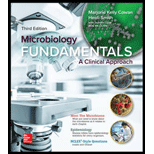
Microbiology Fundamentals: A Clinical Approach
3rd Edition
ISBN: 9781259709227
Author: Marjorie Kelly Cowan Professor, Heidi Smith
Publisher: McGraw-Hill Education
expand_more
expand_more
format_list_bulleted
Question
Chapter 13, Problem 1VC
Summary Introduction
To indicate:
The point where a vaccination might be most effective and also the point where natural infection would play a role.
Concept introduction:
A biological preparation that provides “active acquired immunity” for a particular disease is known as vaccine. The agents present in typical vaccine resemble the microorganisms that cause disease and often made from a dead or weak microbe, its surface protein or toxins. The vaccine stimulates the immunity of the body and prepares the body for future attacks with the same antigen.
Expert Solution & Answer
Trending nowThis is a popular solution!

Students have asked these similar questions
What is the structure and function of Eukaryotic cells, including their organelles? How are Eukaryotic cells different than Prokaryotic cells, in terms of evolution which form of the cell might have came first? How do Eukaryotic cells become malignant (cancerous)?
What are the roles of DNA and proteins inside of the cell? What are the building blocks or molecular components of the DNA and proteins? How are proteins produced within the cell? What connection is there between DNA, proteins, and the cell cycle? What is the relationship between DNA, proteins, and Cancer?
Why cells go through various types of cell division and how eukaryotic cells control cell growth through the cell cycle control system?
Chapter 13 Solutions
Microbiology Fundamentals: A Clinical Approach
Ch. 13.1 - Prob. 1AYPCh. 13.1 - Compare the terms antigen, immunogen, and epitope.Ch. 13.1 - Prob. 3AYPCh. 13.1 - Prob. 4AYPCh. 13.1 - Describe the major histocompatibility complex in...Ch. 13.1 - Prob. 1NPCh. 13.2 - Prob. 6AYPCh. 13.2 - Prob. 7AYPCh. 13.2 - Prob. 8AYPCh. 13.2 - Prob. 9AYP
Ch. 13.2 - Prob. 1MMCh. 13.2 - Prob. 2MMCh. 13.3 - List characteristics of antigens that optimize...Ch. 13.3 - Prob. 11AYPCh. 13.3 - Prob. 12AYPCh. 13.3 - Prob. 2NPCh. 13.4 - Prob. 13AYPCh. 13.4 - Explain how naive T cells become sensitized to an...Ch. 13.4 - Prob. 15AYPCh. 13.5 - Diagram the steps in B-cell activation, including...Ch. 13.5 - Prob. 17AYPCh. 13.5 - Explain the various end results of antibody...Ch. 13.5 - Prob. 19AYPCh. 13.5 - Draw and label a graphwith time on the horizontal...Ch. 13.6 - Prob. 21AYPCh. 13.6 - Discuss the qualities of an effective vaccine.Ch. 13.6 - Name the two major categories of vaccines and then...Ch. 13.6 - Explain the principle of herd immunity and the...Ch. 13.6 - 3. Which characteristic is associated with passive...Ch. 13 - A single bacterium has _______ epitope(s). a. a...Ch. 13 - Prob. 2QCh. 13 - Provide an explanation to refute the following...Ch. 13 - The primary B-cell receptor is a. IgD. b. IgA. c....Ch. 13 - Name three antigen-presenting cells, and what...Ch. 13 - Major histocompatibility molecules are critical...Ch. 13 - In humans, B cells mature in the ___ and T cells...Ch. 13 - Explain how the memory response is the cornerstone...Ch. 13 - Conduct research on clonal deletion and write a...Ch. 13 - Which of the following cells is capable of...Ch. 13 - Is antibody diversity generated at the DNA or RNA...Ch. 13 - In order for gene rearrangement of antigen...Ch. 13 - Prob. 13QCh. 13 - Prob. 14QCh. 13 - Using the details of T-cell activation, suggest a...Ch. 13 - A vaccine that contains parts of viruses is called...Ch. 13 - Explain how herd immunity works to protect the...Ch. 13 - Prob. 18QCh. 13 - Prob. 19QCh. 13 - Chronic lymphocytic leukemia leads to the...Ch. 13 - Prob. 21QCh. 13 - Prob. 1VC
Knowledge Booster
Similar questions
- In one paragraph show how atoms and they're structure are related to the structure of dna and proteins. Talk about what atoms are. what they're made of, why chemical bonding is important to DNA?arrow_forwardWhat are the structure and properties of atoms and chemical bonds (especially how they relate to DNA and proteins).arrow_forwardThe Sentinel Cell: Nature’s Answer to Cancer?arrow_forward
- Molecular Biology Question You are working to characterize a novel protein in mice. Analysis shows that high levels of the primary transcript that codes for this protein are found in tissue from the brain, muscle, liver, and pancreas. However, an antibody that recognizes the C-terminal portion of the protein indicates that the protein is present in brain, muscle, and liver, but not in the pancreas. What is the most likely explanation for this result?arrow_forwardMolecular Biology Explain/discuss how “slow stop” and “quick/fast stop” mutants wereused to identify different protein involved in DNA replication in E. coli.arrow_forwardMolecular Biology Question A gene that codes for a protein was removed from a eukaryotic cell and inserted into a prokaryotic cell. Although the gene was successfully transcribed and translated, it produced a different protein than it produced in the eukaryotic cell. What is the most likely explanation?arrow_forward
- Molecular Biology LIST three characteristics of origins of replicationarrow_forwardMolecular Biology Question Please help. Thank you For E coli DNA polymerase III, give the structure and function of the b-clamp sub-complex. Describe how the structure of this sub-complex is important for it’s function.arrow_forwardMolecular Biology LIST three characteristics of DNA Polymerasesarrow_forward
arrow_back_ios
SEE MORE QUESTIONS
arrow_forward_ios
Recommended textbooks for you
 Human Heredity: Principles and Issues (MindTap Co...BiologyISBN:9781305251052Author:Michael CummingsPublisher:Cengage Learning
Human Heredity: Principles and Issues (MindTap Co...BiologyISBN:9781305251052Author:Michael CummingsPublisher:Cengage Learning Comprehensive Medical Assisting: Administrative a...NursingISBN:9781305964792Author:Wilburta Q. Lindh, Carol D. Tamparo, Barbara M. Dahl, Julie Morris, Cindy CorreaPublisher:Cengage Learning
Comprehensive Medical Assisting: Administrative a...NursingISBN:9781305964792Author:Wilburta Q. Lindh, Carol D. Tamparo, Barbara M. Dahl, Julie Morris, Cindy CorreaPublisher:Cengage Learning

Human Heredity: Principles and Issues (MindTap Co...
Biology
ISBN:9781305251052
Author:Michael Cummings
Publisher:Cengage Learning


Comprehensive Medical Assisting: Administrative a...
Nursing
ISBN:9781305964792
Author:Wilburta Q. Lindh, Carol D. Tamparo, Barbara M. Dahl, Julie Morris, Cindy Correa
Publisher:Cengage Learning


